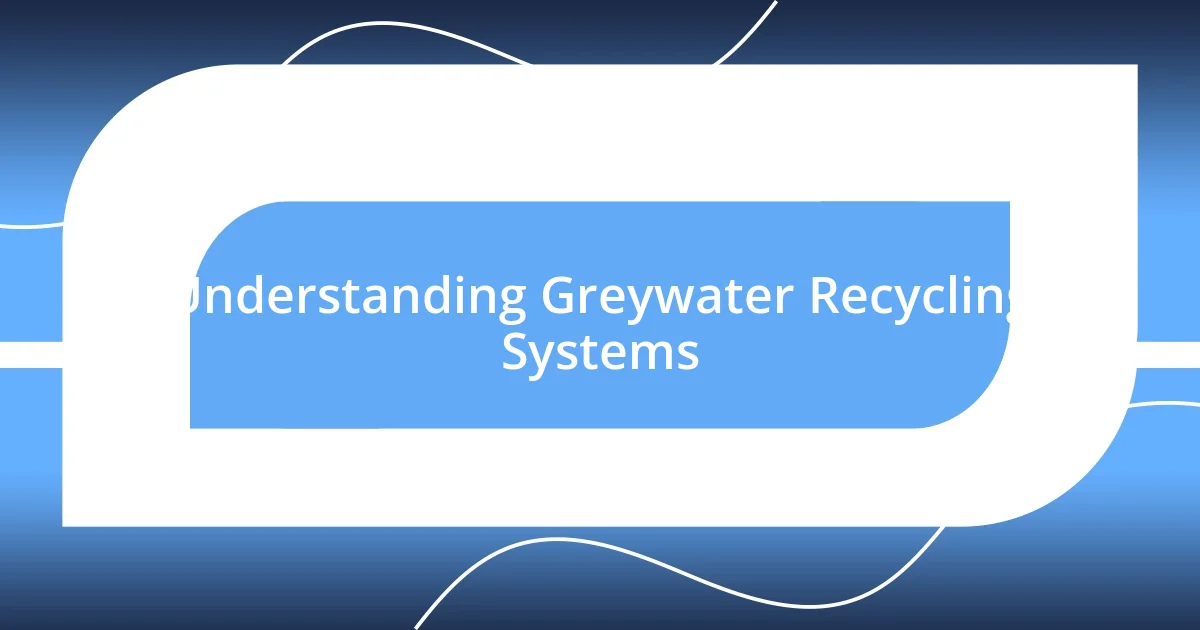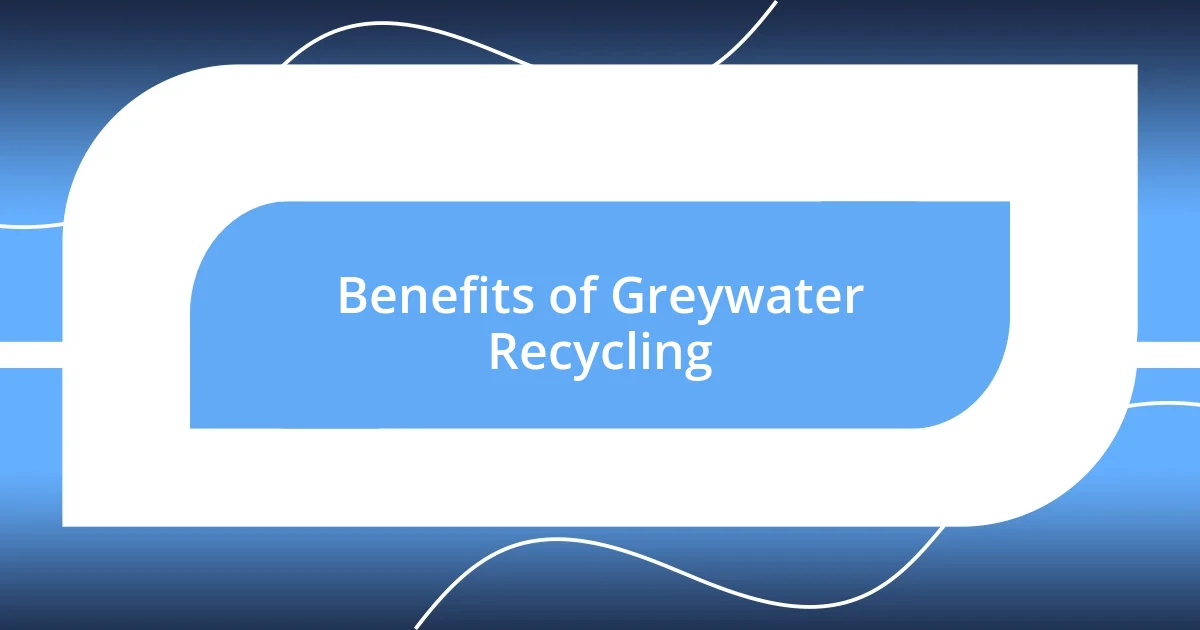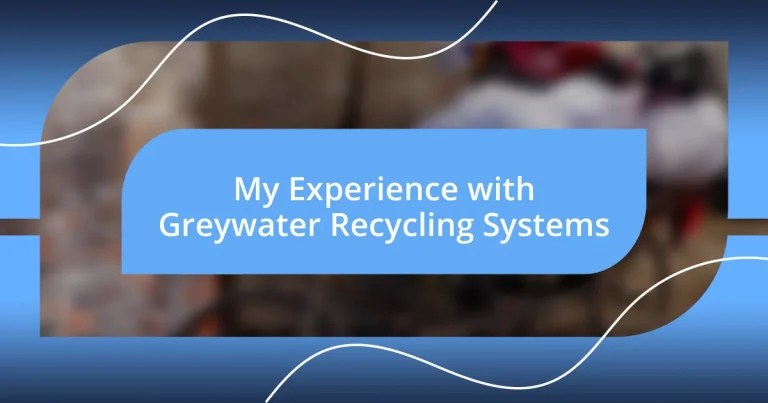Key takeaways:
- Greywater recycling systems reclaim water from sinks, showers, and washing machines, promoting significant water conservation and reducing municipal demand.
- Key components include a diverter valve, filtration system, storage tank, pump, and distribution system, all essential for effective greywater reuse.
- Real-life examples demonstrate successful water savings and environmental benefits, inspiring individuals and businesses to adopt sustainable practices.

Understanding Greywater Recycling Systems
Greywater recycling systems are designed to reclaim water from sources such as sinks, showers, and washing machines, making it reusable for things like irrigation or toilet flushing. I remember the first time I learned about this concept; it struck me as a small step that could lead to significant water conservation, especially in drought-prone areas. Isn’t it fascinating how we often overlook the potential of what seems like simple wastewater?
These systems can vary widely in complexity, from basic setups using a few simple components to more advanced systems that filter and treat greywater for safe reuse. I installed a basic system in my home, and I was surprised at how little maintenance it required. It made me think—why aren’t more people adopting this practice? The ease and efficiency of recycling water right at home can have a profound impact on our environment.
Understanding the regulations and guidelines surrounding greywater reuse is crucial. It’s important to know what’s permissible in your area, as rules differ widely. When I navigated this aspect, I felt a bit overwhelmed at first, but I found resources that clarified the process. Have you ever felt the weight of wanting to make an eco-friendly choice but being unsure where to start? Getting informed transformed my approach to water use, and I truly believe it can empower others, too.

Benefits of Greywater Recycling
Greywater recycling brings a plethora of benefits that are hard to ignore. One of the most significant advantages is the reduction in water consumption. I recall how my water bill plummeted after installing my greywater system. That financial relief was gratifying! It’s exciting to think that reusing water from the shower not only lessens my bills but also contributes to conserving precious resources.
Besides the cost savings, using greywater for irrigation can enhance plant health. I’ve noticed that my garden flourishes like never before when watered with reclaimed greywater. The nutrients present in this type of water seem to provide a subtle boost, promoting robust growth. Isn’t it great that what we once considered waste can nourish the very plants that beautify our homes?
Moreover, embracing greywater recycling fosters a deeper connection to our environment. Each time I use my system, I feel a sense of satisfaction knowing I’m minimizing my ecological footprint. It prompts me to think critically about my water usage and inspires those around me to consider the impact of their habits. How about you? Have you ever pondered how a small change in your routine could ripple out positively?
| Benefit | Description |
|---|---|
| Water Conservation | Reduces overall water consumption by reusing greywater for non-potable uses. |
| Cost Savings | Lowers water bills, offering financial relief through reduced demand on municipal water supplies. |
| Plant Health | Provides nutrients that can enhance soil quality and promote plant growth. |
| Environmental Connection | Encourages mindful water usage, fostering a greater awareness of personal environmental impact. |

Key Components of the System
The key components of a greywater recycling system are essential for its effective operation. One of the first things I learned when setting up my system was the importance of the diverter valve. This clever device directs greywater from the source to either the sewer or the recycling system based on my preference. It may seem small, but its role is crucial in managing the flow of water.
Here’s a breakdown of the main components you’ll encounter:
- Diverter Valve: This directs greywater either to the sewer line or to the treatment system.
- Filtration System: Removes debris and particulates, ensuring that the greywater collected is clean enough for reuse.
- Storage Tank: Holds the treated greywater until it’s needed for irrigation or other non-potable uses.
- Pump: Moves the greywater from the storage tank to the points of use, like garden beds or toilets.
- Distribution System: Delivers the reclaimed greywater to the desired location, often involving buried hoses or drip irrigation.
When I first explored these components, I was intrigued by how each piece played a unique role in the system’s efficiency. It felt a bit like putting together a puzzle, where each part needed to fit just right. I spent some time researching and even took a few DIY approaches, which gave me a sense of accomplishment. Have you ever felt that thrill when you piece something together successfully? That moment of realization – you’re not just saving water, but actively participating in a sustainable future – is incredibly rewarding.

Installation Process of Greywater Systems
When I embarked on my greywater system installation, I didn’t realize how hands-on the process would be. First, I had to assess my home layout and decide where to best install the diverter valve, which I found fascinating. There’s something empowering about becoming that involved in your home’s functionality; it’s like you’re giving your home a water system upgrade!
Next came the filtration system – I was pleasantly surprised by how straightforward it was to install. I remember feeling a sense of responsibility as I meticulously followed the instructions, ensuring not a speck of debris could contaminate the greywater. Does that kind of attention to detail resonate with you? It’s a true testament to the importance of keeping things clean and sustainable.
Once everything was set up, I was itching to see the system in action. I vividly recall the first time I pumped reclaimed water into my garden. The thought that I had transformed what would have gone down the drain into life-giving moisture sent a wave of satisfaction through me. What could be better than seeing your plants thrive, all while contributing to water conservation? It’s a rewarding cycle I cherish every day.

Maintenance Tips for Greywater Systems
To keep your greywater system running smoothly, regular cleaning is essential. I remember the first time I checked my filtration system—it felt like I was unearthing a little treasure! Just a simple rinse to remove accumulated debris made a noticeable difference in how well water flowed through the setup. Ensuring your filters are clean not only enhances efficiency but also prolongs the life of your system. Have you checked yours lately?
Next, I learned the importance of inspecting the diverter valve frequently. The first time I noticed a slight blockage, I was thankful I caught it early—it saved me a lot of potential headaches later. I recommend doing a quick inspection every few months. It’s akin to giving your system a health check-up. Trust me, staying on top of these little tasks will prevent bigger problems down the line.
Lastly, keeping an eye on plant responses is vital for maintaining your system’s effectiveness. I often observed how my garden flourished with greywater; when it didn’t, it was a wake-up call. Perhaps some plants weren’t suited for the nutrients in the water. Adjusting my irrigation based on their needs taught me that greywater management is a dynamic process. Have you noticed how your plants react to reclaimed water? They can tell you a lot about the health of your system!

Real Life Case Studies
When I was exploring greywater recycling systems, I stumbled upon a family in California that had transformed their water usage. They managed to reduce their water bill by a staggering 50% after installing a system that diverted shower and laundry water to irrigation. Watching their yard flourish from what would typically be wasted water was a remarkable testament to the project’s success. Have you ever considered how much water we flush away daily?
Another inspiring case I encountered was a small coffee shop in Oregon. They implemented a greywater system that recycled water from their espresso machine for use in their landscaping. The owner shared how not only did it lower their water expenses, but it also resonated with their commitment to sustainability. It’s incredible to see how such businesses can intertwine their operations with eco-friendly practices. How often do we think about the ripple effect of our choices on the environment?
Finally, I recall visiting a community garden that had adopted greywater systems as part of their initiative to promote sustainable practices. The garden thrived on water sourced from nearby homes—a brilliant approach to resource sharing. The volunteers spoke passionately about how this initiative turned their garden not just into a place for plants but a hub for education on sustainability. Seeing that camaraderie and enthusiasm was truly uplifting. What do you think inspires people to adopt sustainable practices like this?












